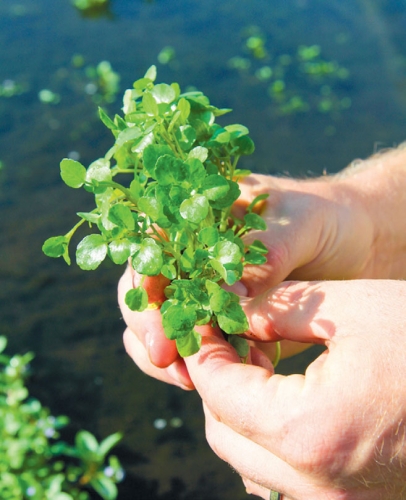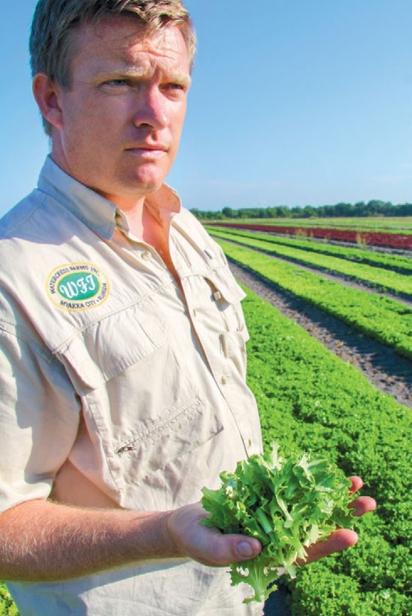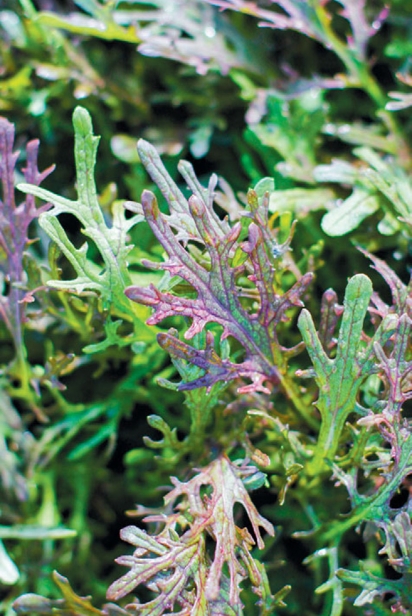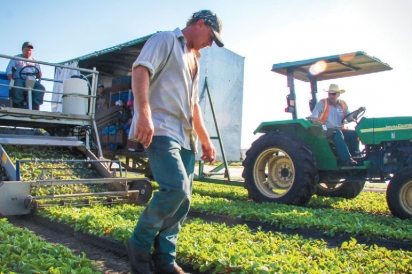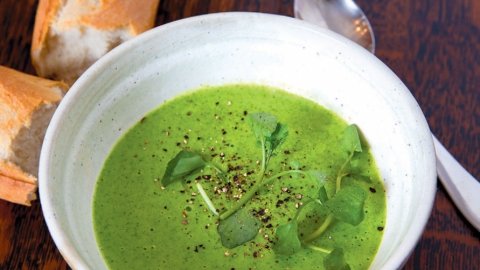Field and Stream
A Myakka City farm fills British grocery shelves with hundreds of tons of precision-grown watercress. A ride around Watercress Farms with Guy Averill begins with a history lesson—the history of watercress, of course.
Averill carefully maneuvers his truck down long, pocked dirt roads that run next to rows of dirt beds that will soon be laser-leveled and planted with watercress seeds in preparation for the Myakka City farm’s October–May growing season. The truck bops and rattles as it passes bed after bed while Averill unspools the long history of the 500-acre farm’s namesake peppery green.
Humans have eaten watercress for millennia. Romans, Anglo- Saxons, the Irish, Greeks, Persians—all of them consumed the plant, which grows abundantly in flowing water in springs and creeks. But it was in England where the widespread cultivation of watercress reached its apex. The population explosion created by the Industrial Revolution led to huge demand for an inexpensive, healthy green vegetable that grew during the winter. The watercress business eventually got so big an entire railway line developed to transport the greens from farms in southern England up to London. Today, watercress remains a British staple, a heritage food that appears in salads, sandwiches and soups.
But the production process has certainly changed. The Watercress Company, Watercress Farms’ parent company, now grows the crop during the summer in the United Kingdom and during the winter at three farms in Spain and here, out in Myakka City. The company came to Southwest Florida in 1995, hoping to situate farms in different climate zones so that if one region suffers brutal weather, other farms in other areas can pick up the slack.
“Our aim is to provide the same crop 365 days a year,” says Averill, a 38-year-old Midlands native, who came to Myakka City 15 years ago. “With globalization, Mrs. Jones wants a salad whether it’s the day after Christmas or the Fourth of July. There’s no seasonality involved.”
A typical watercress bed takes up about one-third of an acre, a long rectangle that slopes slightly to allow water to trickle across its surface. Watercress will not grow in still water. The beds’ water level also rises as the watercress grows, beginning at 1/16 of an inch and increasing up to 5/16. Watercress Farms is home to 206 such beds that together crank out around 500 tons of watercress each season. The farm also grows 300 tons of spring mix salad greens.
Almost all of that ends up on English grocery store shelves. During season, the farm—which uses conventional, not organic, practices— harvests the greens, vacuum-cools them and ships them on planes from Orlando every single day. It takes just 72 hours for the watercress to get from a field in Myakka City onto store shelves in the UK. The Watercress Company typically fills roughly 60 percent of the UK market, Averill estimates. This year, so far, that number is up around 75 percent.
The international character of Watercress Farms’ business means the company must follow a number of stringent rules, including government regulations imposed by both the United States and the UK, as well as environmental improvements dictated by the grocery stores with whom Watercress Farms does business. The company recently spent $250,000 on a new, fully enclosed electric pump system that is significantly reducing the amount of water lost through evaporation and seepage. It’s also cutting the farm’s carbon footprint and fuel costs “dramatically,” Averill says.
That investment in creating the best possible product in a sustainable way is Watercress Farms’ calling card, according to Averill. “It’s paying back financially, but also when we come to our customers, we can say, ‘Our carbon footprint has reduced by X,’” Averill says. “In Europe they’re very conscious of that. Grocery stores want to say, ‘We’re reducing our waste, our packaging, everything.’”
It’s not just Europeans who are fans, though. Watercress Farms has begun selling some of its greens to local eateries through the Suncoast Food Alliance, the farm-to-restaurant distribution service founded by John Matthews, as well as Sarasota’s Central Market distributor. Last January, Watercress also began teaming with Sarasota County Schools to provide greens for local school salads.
Those local endeavors represent a small slice of Watercress Farms’ global business so far. Averill estimates maybe eight tons of salad greens went to local customers last year, compared to 300 shipped overseas. But they represent a significant step nonetheless. Averill says the connection to local schools simply underscores his staff’s deep roots in their community. “It’s where our kids go to school,” he says. “My kids are eating this stuff.”
That concern for providing the highest quality possible reflects how “emotionally invested” the staff is in protecting Watercress Farms’ standing and reputation, Averill says: “If it rains, we don’t sleep.” Humans have been eating watercress since forever. That’s a lot of history to live up to.
► Watercress Farms: 13060 Sugar Bowl Rd, Myakka City; 941-322-0600; watercressfarms.com


